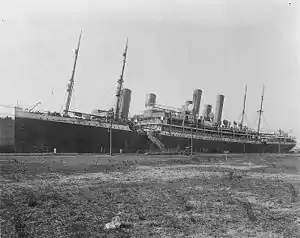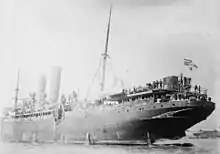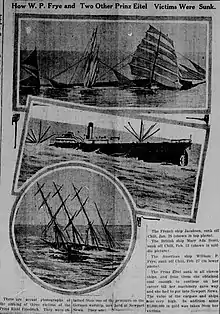SS Prinz Eitel Friedrich (1904)
SS Prinz Eitel Friedrich was a German passenger liner which saw service in the First World War as an auxiliary cruiser of the Imperial German Navy. Though largely overlooked, Prinz Eitel Friedrich was, after SS Kronprinz Wilhelm, the most successful of Germany’s first wave of auxiliary cruisers. She was able to remain at large for seven months, from August 1914 to March 1915, and sank 11 ships, for a total tonnage of 33,000 GRT.
 SS Prinz Eitel Friedrich on 28 March 1917, interned at the Philadelphia Navy Yard, Pennsylvania | |
| History | |
|---|---|
| Name: | Prinz Eitel Friedrich |
| Builder: | Vulcan. Stettin |
| Launched: | 1904 |
| Commissioned: | 5 August 1914[1](p46) |
| Fate: | Interned 1915, seized 1917 |
| General characteristics | |
| Displacement: | |
| Length: | 153.3 m (503 ft) |
| Beam: | 16.9 m (55 ft) |
| Draught: | 7.1 m (23 ft) |
| Propulsion: | 2 × 4 cylinder expansion |
| Speed: | 15 kn (28 km/h) |
| Range: | 10,000 nm |
| Complement: | 402[1](p24) |
| Armament: |
|
Early career
Prinz Eitel Friedrich was built for the Norddeutscher Lloyd, a former shipping company of the Hapag-Lloyd, by the AG Vulcan shipyard in Stettin, in 1904. For the ten years prior to the First World War she served on NDL routes in the Far East. On the eve of war in August 1914 she was at Shanghai, with orders to proceed to the German naval base at Tsingtao for conversion as an auxiliary cruiser (Hilfskreuzer).[2](p72)
Service history
At Tsingtao Prinz Eitel Friedrich was equipped for her role as a commerce raider, transferring the armaments and crews of the aging gunboats Luchs, and Tiger. KK Max Therichens, of Luchs, took command.
She was commissioned on 5 August 1914 and sailed from Tsingtao the same day to join company with Admiral Graf von Spee and the German East Asia Squadron. These were at Pagan in the Caroline Islands, and Prinz Eitel Friedrich arrived there on 12 August.
On 13 August she was detached for independent operations and with a remit to attack and destroy allied commerce. She sailed south to start this mission along the coast of Australia.[2](p72)
In the following seven months she operated in the Pacific and South Atlantic, sinking 11 vessels, mostly sailing ships, for a total of 33,423 gross register tons (GRT).
In March 1915, with her bunkers nearly empty and her engines worn out, Prinz Eitel Friedrich headed for the neutral United States, and on 11 March 1915 sailed into Newport News harbour, to be interned.[2](p82)
Armament

Four 10.5 cm SK L/40 cannons. Two each mounted fore and aft. The port aft gun pictured at right.
An original 10.5 cm SK L/40 naval gun from Prinz Eitel Friedrich can be seen at the Cambridge Memorial Park.[3][4]
Table

| Date | Ship | Type | Nationality | Tonnage GRT | Fate |
|---|---|---|---|---|---|
| 5.12.1914 | Charcas | Freighter | British | 5,067 | Sunk |
| 11.12.1914 | Jean | Sailing ship | French | 2,207 | Retained as collier Scuttled 31.12.14 |
| 12.12.1914 | Kidalton | Sailing ship | British | 1,784 | Sunk |
| 26.1.1915 | Isabel Browne | Sailing ship | Russian | 1,315 | Sunk |
| 27.1.1915 | Pierre Lott | Sailing ship | French | 2,196 | Sunk |
| 27.1.1915 | William P Frye* | Sailing ship | American | 3,374 | Sunk |
| 28.1.1915 | Jacobsen | Sailing ship | French | 2,195 | Sunk |
| 12.2.1915 | Invercoe | Sailing ship | British | 1,421 | Sunk |
| 18.2.1915 | Mary Ada Short | Sailing ship | British | 3,605 | Sunk |
| 19.2.1915 | Floride | Freighter | French | 6,629 | Sunk |
| 20.2.1915 | Willerby | Freighter | British | 3,630 | Sunk |
- William P Frye was the first U.S. ship sunk during World War I. Its sinking urged the neutral U.S. to enter the war.
Internment and United States flag
Prinz Eitel Friedrich failed to leave the neutral port in the time prescribed by international law and was interned on 9 April 1915. The ship, still under the German flag, moved, was moved to the Philadelphia Navy Yard where, upon the United States declaration of war with Germany on 6 April 1917, she was seized by U.S. Customs officials and then transferred to the Navy.[5]
U.S. Naval service
Reconditioned and refitted as a troop transport and given the identification number (Id.No.) 3010, she was renamed and commissioned USS DeKalb (ID-3010) at the Philadelphia Navy Yard on 12 May 1917, Cmdr. Walter R. Gherardi in command. DeKalb served for the remainder of the war as a troopship on the trans Atlantic route.[5]
Immigrant ship
The ship was acquired by W. Averell Harriman and included with ten previous ships acquired from the Kerr Navigation Company in a name change so that all were prefixed with an American mountain and thus renamed Mount Clay.[6] The ship was specially modified to be a steerage only immigrant ship for the United American Line of New York.[7] Mount Clay made the initial voyage as an immigrant ship on Christmas Day 1920 (Marine Review) or 26 December (DANFS).[6][5]
Mount Clay made the last westbound voyage from Hamburg to New York on 15 October 1925 and was laid up until scrapped in 1934.[5]
References
- Schmalenbach, Paul (1979). German raiders: A history of auxiliary cruisers of the German Navy, 1895-1945 (First ed.). Annapolis: Naval Institute Press. ISBN 0-85059-351-4.
- Halpern, Paul G. (1994). Naval History of World War I (2nd hardcover printing ; 1st paperback printing. ed.). London: U. C. L. P. ISBN 1-85728-295-7.
- Costello, Michael. "10.5 cm/40 SK L/40". NavWeaps, Naval Weapons, Naval Technology and Naval Reunions. Tony DiGiulian. Retrieved 2 February 2016.
- DiGiulian, Tony. "Germany 10.5 cm/40 (4.1") SK L/40 - NavWeaps". www.navweaps.com.
- Havern, Christopher B., Sr. (2 May 2018). "DeKalb (Id. No. 3010)". Dictionary of American Naval Fighting Ships. Naval History And Heritage Command. Retrieved 29 August 2018.CS1 maint: multiple names: authors list (link)
- "W. A. Harriman as a Ship Operator". The Marine Review. Vol. 51 no. April. 1921. p. 178. Retrieved 29 August 2018.
- "An Immigrant Ship, De Luxe". The Marine Review. Vol. 51 no. February. 1921. p. 56. Retrieved 29 August 2018.
External links
- Macina, Mark A. (1995). "6". The United States Versus Great Britain and Germany: American Diplomatic Correspondence and Efforts to Remain Neutral, 1914-1915. Fort Worth, Texas: Mark A. Macina. Retrieved 2 February 2016.